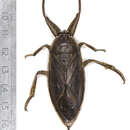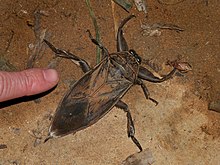ar
الأسماء في صفحات التنقل


Lethocerus is a genus of the hemipteran family Belostomatidae, known colloquially as giant water bugs, toe biters and electric light bugs, distributed in tropical, subtropical and temperate areas of the world.[1][2] The greatest diversity of species occurs in the Americas, with only a single species in Europe, two in Africa, two in Australia and three in Asia.[2] It includes the largest true bugs with species capable of reaching a length of over 12 centimetres (4.7 in).[3] The South American L. grandis and L. maximus are the only species to commonly exceed 9 cm (3.5 in), with more typical lengths for the remaining species being between 4.5 and 9 cm (1.8 and 3.5 in).[2] Lethocerus sp. are distinguished from other genera in the Lethocerinae (Benacus and Kirkaldyia) by two symmetrical furrows in the inner pad of setae on the fore femur, the external borders of parasternites II and III narrowed and nearly straight, and with the setae of the tarsomeres following the line of the tibial setae.
Unlike giant water bugs in the subfamily Belostomatinae, females do not lay the eggs on the backs of males.[4] Instead, after copulation (often multiple sessions[5]) the eggs are laid on emergent vegetation (rarely on man-made structures) high enough above the waterline that the eggs will not be permanently submerged. The male then guards the eggs from predators and periodically brings water to the eggs to prevent their desiccation.[6]
Like other members of the giant water bug family, Lethocerus species are predators that overpower prey by stabbing it with the rostrum and injecting a saliva that includes a number of enzymes that break down proteins.[7] As many as 132 components have been found in their saliva or venom, several being similar to those found in assassin bugs.[8] The proboscis is then used to suck the liquified and semi-digested body fluid of the prey. The rostrum can also be used in self-defense, and the bite is very painful to humans, causing swelling and pulsating pain, but usually resolves within about five hours at most.[9]
Lethocerus adults are attracted to lights (hence the name electric light bug) and are attracted in large numbers as they disperse from one water body to another during the rainy season. Some species are eaten, particularly in Southeast Asia and a few are endangered.[10]

As of 2006, this is an exhaustive listing of all known species of Lethocerus:[2]
The oldest known fossil of the genus is an indeterminate species from the Bembridge Marls, Isle of Wight, UK.[11]
In addition to these, Lethocerus deyrollei, which is one of the best known giant water bugs, has traditionally been included in this genus, but in 2006 it was moved to Kirkaldyia.[2]
Lethocerus is a genus of the hemipteran family Belostomatidae, known colloquially as giant water bugs, toe biters and electric light bugs, distributed in tropical, subtropical and temperate areas of the world. The greatest diversity of species occurs in the Americas, with only a single species in Europe, two in Africa, two in Australia and three in Asia. It includes the largest true bugs with species capable of reaching a length of over 12 centimetres (4.7 in). The South American L. grandis and L. maximus are the only species to commonly exceed 9 cm (3.5 in), with more typical lengths for the remaining species being between 4.5 and 9 cm (1.8 and 3.5 in). Lethocerus sp. are distinguished from other genera in the Lethocerinae (Benacus and Kirkaldyia) by two symmetrical furrows in the inner pad of setae on the fore femur, the external borders of parasternites II and III narrowed and nearly straight, and with the setae of the tarsomeres following the line of the tibial setae.
Lethocerus est un genre de punaises géantes de la famille des bélostomatidés.
Lethocerus é um gênero de insetos hemípteros.[1]
Lethocerus é um gênero de insetos hemípteros.
田鱉屬(學名:Lethocerus)屬於半翅目負蝽科的一个属,属于水生昆蟲。
棲息於低海拔或平地的水田、池塘、淨水域、等等水生生物棲息地,但因水生環境汙染而數量減少。
田鱉屬昆蟲通常有分為两类,一类是較為常見的種類例如:負子蝽,體型不大,最大約4公分左右,雄蟲與雌蟲交配後,雌蟲會將卵塊產於雄蟲背上,皆由雄蟲負責照顧背上的卵塊直到孵化,而雌蟲產完後會自行離開;而另一类則是較大型數量較少的品種,例如:大田鱉,體型最大可超出5公分,最大品種相當於世界最大甲蟲的尺寸,有著「巨魚殺手」(giant fish killers)的特名[1],會攻擊體型比自己大的生物,但這種大型種將不會把卵塊產於雄蟲背上[1],則是將卵塊產於不會接觸到水面的各種竿狀水生植物上,並由雄蟲擔任守衛捍衛天敵,並在卵塊上提供適當的水分防止其乾燥直到孵化。